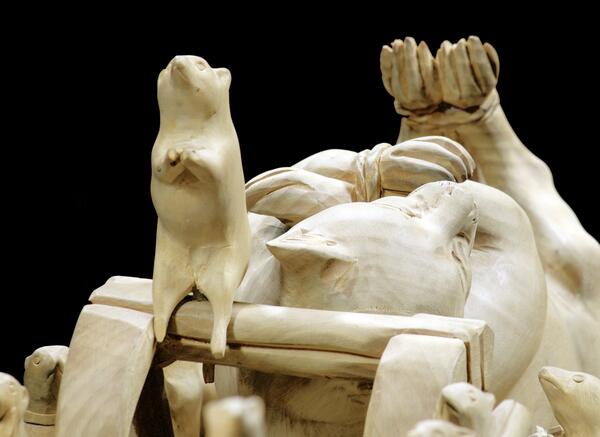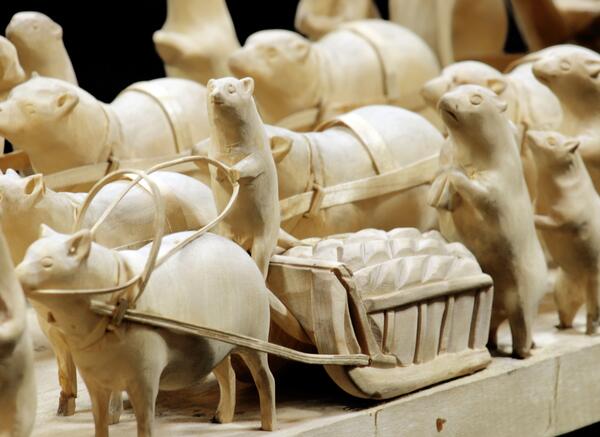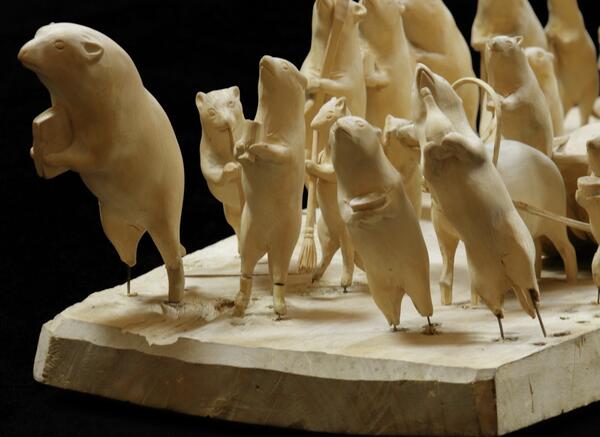The large sculptural group “How Mice Buried a Cat” was made in the workshops of Sergiev Posad, which also employed Bogorodskoye craftsmen. The public was interested in the significant achievement of carved wooden craft as evidenced by the fact that the sculpture was reproduced in several versions, which later entered museum collections.
This composition titled “How Mice Buried a Cat” was created by the hereditary Bogorodskoye carver Filipp Dmitrievich Eroshkin (1879–1936). The master tried to express the humor of the so-called “amusing sheets”, from which this plot was borrowed. It is interesting to observe the figures and compare them with the explanatory descriptions of the popular print, some of them being very rude.
The old parable about a cunning cat that pretended to be dead, has been known since the times of Ancient Egypt and Aesop’s fables. In Russia, it has acquired peculiar national features. Its content in different epochs was interpreted in accordance with the realities of the time, but always in the spirit of the “topsy-turvy world”.
The earliest Russian woodcuts on this subject date back to the 17th century, and then the subject began to be used in copper engraving. The image is accompanied by a text with an ironic description of each character in this procession.
“The noble underground mice, convicted for petty misdemeanor, finally put the cat on the Chukhna cart, tied its paws, they want to quench their sadness, and drown the cat in the… pit …”, “… a short mouse carries a shovel to dig a pit …”, “Churila Sarnach plays the flute, but he does not know the harmony …”, “… a mouse from the little Chukhna Malanya carries a sleigh full of pancakes …”, “… mice carry sick mice on themselves and take no payment… .”
The village of Bogorodskoye is located 20 kilometers from Sergiev Posad. Since the 18th century, local dynasties of craftsmen carved wooden toys and sculptures — the so-called “dolls”. These products were sold in shops near the walls of the Trinity-Sergius Lavra, and then in both capitals. Bogorodskoye movable toys were especially popular — bears and blacksmiths, which have become a symbol of this folk craft.
The 1900s were a turning point for the development of the Bogorodskoye carving industry, and this was due to the organizational skills of the artist Nikolay Dmitrievich Bartram, the curator of toy crafts at the Moscow Handicraft Museum. He sought to involve village craftsmen in exhibition activities, which contributed to the popularity of the craft. It was necessary to create new large compositions related to folklore, memorable exhibition items that would attract the viewer’s attention. It was Bartram who suggested that the carvers make a wooden sculpture depicting this famous plot from popular print — “Mice Bury a Cat”.
This composition titled “How Mice Buried a Cat” was created by the hereditary Bogorodskoye carver Filipp Dmitrievich Eroshkin (1879–1936). The master tried to express the humor of the so-called “amusing sheets”, from which this plot was borrowed. It is interesting to observe the figures and compare them with the explanatory descriptions of the popular print, some of them being very rude.
The old parable about a cunning cat that pretended to be dead, has been known since the times of Ancient Egypt and Aesop’s fables. In Russia, it has acquired peculiar national features. Its content in different epochs was interpreted in accordance with the realities of the time, but always in the spirit of the “topsy-turvy world”.
The earliest Russian woodcuts on this subject date back to the 17th century, and then the subject began to be used in copper engraving. The image is accompanied by a text with an ironic description of each character in this procession.
“The noble underground mice, convicted for petty misdemeanor, finally put the cat on the Chukhna cart, tied its paws, they want to quench their sadness, and drown the cat in the… pit …”, “… a short mouse carries a shovel to dig a pit …”, “Churila Sarnach plays the flute, but he does not know the harmony …”, “… a mouse from the little Chukhna Malanya carries a sleigh full of pancakes …”, “… mice carry sick mice on themselves and take no payment… .”
The village of Bogorodskoye is located 20 kilometers from Sergiev Posad. Since the 18th century, local dynasties of craftsmen carved wooden toys and sculptures — the so-called “dolls”. These products were sold in shops near the walls of the Trinity-Sergius Lavra, and then in both capitals. Bogorodskoye movable toys were especially popular — bears and blacksmiths, which have become a symbol of this folk craft.
The 1900s were a turning point for the development of the Bogorodskoye carving industry, and this was due to the organizational skills of the artist Nikolay Dmitrievich Bartram, the curator of toy crafts at the Moscow Handicraft Museum. He sought to involve village craftsmen in exhibition activities, which contributed to the popularity of the craft. It was necessary to create new large compositions related to folklore, memorable exhibition items that would attract the viewer’s attention. It was Bartram who suggested that the carvers make a wooden sculpture depicting this famous plot from popular print — “Mice Bury a Cat”.








